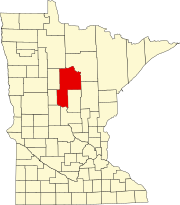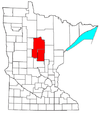Walker, Minnesota
Walker, Minnesota | |
|---|---|
City | |
 Photo: Erlend Bjørtvedt | |
| Nickname: "Where People Come to Play" | |
 | |
| Country | United States |
| State | Minnesota |
| County | Cass |
| Area | |
| • Total | 2.47 sq mi (6.40 km2) |
| • Land | 2.47 sq mi (6.40 km2) |
| • Water | 0 sq mi (0 km2) |
| Elevation | 1,316 ft (401 m) |
| Population | |
| • Total | 941 |
| • Estimate (2013[3]) | 928 |
| • Density | 381.0/sq mi (147.1/km2) |
| Time zone | UTC-6 (Central (CST)) |
| • Summer (DST) | UTC-5 (CDT) |
| ZIP code | 56484 |
| Area code | 218 |
| FIPS code | 27-67792 |
| GNIS feature ID | 0658881[4] |
| Website | walker.govoffice.com |
Walker is a city in Cass County, Minnesota, United States. The population was 941 at the 2010 census.[5] It is the county seat of Cass County.[6]
Walker is part of the Brainerd Micropolitan Statistical Area.
Minnesota State Highways 34, 200, and 371 are three of the main routes in the city.
History

The area was inhabited for thousands of years by succeeding cultures of indigenous peoples. Before European settlement, the Ojibwe moved into the area from the Great Lakes, pushing out the historic Dakota peoples, such as the Assiniboine and Hidatsa. European American settlers followed the early fur traders and trappers, and encroached on Native American territories.
Following the construction of the railroad to the area, Patrick McGarry founded Walker in 1896. He named the settlement after the logging giant Thomas B. Walker, in hopes of luring construction of a sawmill. Thomas B. Walker instead chose to found and set up operations in nearby Akeley, because of his wife's moral objection to the bars and brothels in Walker, a rough frontier town. Walker developed with business, jobs and other services generated by four other logging companies.
Tourism later grew as a service industry. In the twentieth century, people from urban areas came to more rural areas for recreation associated with lakes, fishing, hunting and water sports. The city reached its peak of population in 1950.
In 1907, Walker became the home of the Ah-Gwah-Ching Center, first constructed as a residential facility for tuberculosis (TB) patients, who at the time could be treated only with good nutrition and rest.[7] By 1927, it had 300 patients. The large facility had its own farm and dairy herd, the patients and staff put on skits and produced a newspaper, and it had its own railroad depot at one time. During the Great Depression, it was a site for display of art produced by artists paid by the Works Progress Administration, and has the largest WPA art collection in the state. In 1962, the facility was adapted as a state nursing home for psychiatric patients. The complex is listed on the National Register of Historic Places.[7]
Geography
Walker is located on the southwest corner of Leech Lake, the third largest lake in Minnesota. According to the United States Census Bureau, the city has a total area of 2.47 square miles (6.40 km2), all of it land.[1] Nearby cities and towns include Hackensack, Akeley, Whipholt, Laporte, Bemidji, and Onigum. The latter is one of eleven communities that make up the Leech Lake Indian Reservation.
Climate
| Climate data for Walker, Minnesota | |||||||||||||
|---|---|---|---|---|---|---|---|---|---|---|---|---|---|
| Month | Jan | Feb | Mar | Apr | May | Jun | Jul | Aug | Sep | Oct | Nov | Dec | Year |
| Mean daily maximum °F (°C) | 17 (−8) |
24 (−4) |
33 (1) |
51 (11) |
64 (18) |
73 (23) |
78 (26) |
75 (24) |
66 (19) |
53 (12) |
35 (2) |
23 (−5) |
49 (10) |
| Mean daily minimum °F (°C) | −2 (−19) |
3 (−16) |
15 (−9) |
30 (−1) |
41 (5) |
51 (11) |
57 (14) |
55 (13) |
44 (7) |
35 (2) |
21 (−6) |
5 (−15) |
30 (−1) |
| Average precipitation inches (mm) | 0.7 (18) |
0.6 (15) |
1.2 (30) |
2.0 (51) |
2.9 (74) |
4.0 (100) |
3.7 (94) |
3.4 (86) |
2.7 (69) |
2.0 (51) |
1.2 (30) |
0.8 (20) |
25.3 (640) |
| Source: weatherbase.com[8] | |||||||||||||
Demographics
| Census | Pop. | Note | %± |
|---|---|---|---|
| 1900 | 500 | — | |
| 1910 | 917 | 83.4% | |
| 1920 | 785 | −14.4% | |
| 1930 | 618 | −21.3% | |
| 1940 | 939 | 51.9% | |
| 1950 | 1,192 | 26.9% | |
| 1960 | 1,180 | −1.0% | |
| 1970 | 1,073 | −9.1% | |
| 1980 | 970 | −9.6% | |
| 1990 | 950 | −2.1% | |
| 2000 | 1,069 | 12.5% | |
| 2010 | 941 | −12.0% | |
| 2015 (est.) | 928 | [9] | −1.4% |
| U.S. Decennial Census[10] 2013 Estimate[3] | |||
2010 census
As of the census[2] of 2010, there were 941 people, 452 households, and 205 families residing in the city. The population density was 381.0 inhabitants per square mile (147.1/km2). There were 605 housing units at an average density of 244.9 per square mile (94.6/km2). The racial makeup of the city was 88.0% White, 7.2% Native American, 1.1% Asian, 0.5% from other races, and 3.2% from two or more races. Hispanic or Latino of any race were 1.3% of the population.
There were 452 households of which 21.2% had children under the age of 18 living with them, 33.4% were married couples living together, 8.4% had a female householder with no husband present, 3.5% had a male householder with no wife present, and 54.6% were non-families. 48.0% of all households were made up of individuals and 23.4% had someone living alone who was 65 years of age or older. The average household size was 1.93 and the average family size was 2.82.
The median age in the city was 49 years. 19.2% of residents were under the age of 18; 5% were between the ages of 18 and 24; 20.9% were from 25 to 44; 24.9% were from 45 to 64; and 30.1% were 65 years of age or older. The gender makeup of the city was 44.5% male and 55.5% female.
2000 census
As of the census of 2000, there were 1,069 people, 449 households, and 258 families residing in the city. The population density was 734.3 people per square mile (282.7/km²). There were 517 housing units at an average density of 355.1 per square mile (136.7/km²). The racial makeup of the city was 88.59% White, 0.09% African American, 8.98% Native American, 0.28% Asian, 0.28% from other races, and 1.78% from two or more races. Hispanic or Latino of any race were 1.03% of the population.
There were 449 households out of which 24.7% had children under the age of 18 living with them, 43.7% were married couples living together, 10.0% had a female householder with no husband present, and 42.5% were non-families. 39.0% of all households were made up of individuals and 22.5% had someone living alone who was 65 years of age or older. The average household size was 2.16 and the average family size was 2.86.
In the city the population was spread out with 22.5% under the age of 18, 5.7% from 18 to 24, 26.1% from 25 to 44, 21.0% from 45 to 64, and 24.6% who were 65 years of age or older. The median age was 42 years. For every 100 females there were 92.3 males. For every 100 females age 18 and over, there were 86.9 males.
The median income for a household in the city was $33,125, and the median income for a family was $44,063. Males had a median income of $31,324 versus $25,435 for females. The per capita income for the city was $17,079. About 8.0% of families and 12.4% of the population were below the poverty line, including 15.3% of those under age 18 and 14.7% of those age 65 or over.
Education
Walker Public Schools are part of the Walker-Hackensack-Akeley School District. Schools in the district include Walker-Hackensack-Akeley Elementary School and Walker-Hackensack-Akeley High School (WHA). Boyd McLarty is currently serving as the interim Superintendent of Schools.[11]
Walker is home to Walker-Hackensack-Akeley High School, and Immanuel Lutheran School.
Media
TV stations
Walker is part of the Minneapolis / Saint Paul television market.
KCCW-TV is a full power station licensed to Walker on channel 12 with transmitter located east of Hackensack on Woman Lake Road (Cass County Road 5). It does not originate programming but rebroadcasts CBS O&O WCCO-TV with no local input. Walker also has several translators from stations KMSP-TV, KARE-TV, and KSAX-TV.
Cable and satellite television signals are also available.
Newspaper
The Pilot Independent / Co-Pilot Shopper newspaper website
Radio stations
- FM radio
- 88.5 Minnesota Public Radio (MPR)
- 92.5 KXKK
- 94.5 KDLB
- 97.5 KDKK
- 99.1 KLLZ-FM Z99 Classic Rock
- 101.9 KQKK
- 102.5 KKWB-FM
- 104.3 KLKS
- AM radio
Notable people
- Mary Welsh Hemingway, journalist, wife of Ernest Hemingway
References
- ^ a b "US Gazetteer files 2010". United States Census Bureau. Retrieved November 13, 2012.
- ^ a b "American FactFinder". United States Census Bureau. Retrieved November 13, 2012.
- ^ a b "Population Estimates". United States Census Bureau. Retrieved July 14, 2014.
- ^ "US Board on Geographic Names". United States Geological Survey. October 25, 2007. Retrieved January 31, 2008.
- ^ "2010 Census Redistricting Data (Public Law 94-171) Summary File". American FactFinder. U.S. Census Bureau, 2010 Census. Retrieved April 23, 2011.
- ^ "Find a County". National Association of Counties. Retrieved June 7, 2011.
- ^ a b Andris Straumanis, "Ah-Gwa-Ching", Minnesota Public Radio, July 26, 2004. Retrieved March 8, 2012
- ^ "Historical weather for Walker, Minnesota USA". Retrieved January 8, 2009.
- ^ "Annual Estimates of the Resident Population for Incorporated Places: April 1, 2010 to July 1, 2015". Retrieved July 2, 2016.
- ^ United States Census Bureau. "Census of Population and Housing". Retrieved July 14, 2014.
- ^ "Walker Hackensack Akeley Schools". Walker Hackensack Akeley Schools. Retrieved June 26, 2012.
External links
- WalkerMN.com
- Leech Lake Area Chamber of Commerce
- Ancient Stone Tools Found; May Be Among Americas' Oldest. Stefan Lovgren for National Geographic News. February 15, 2007
- History of Walker and Leech Lake
- Leech Lake Ojibwe


